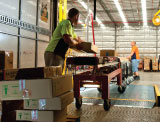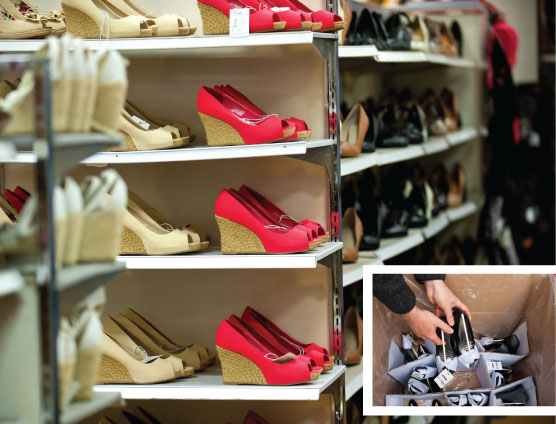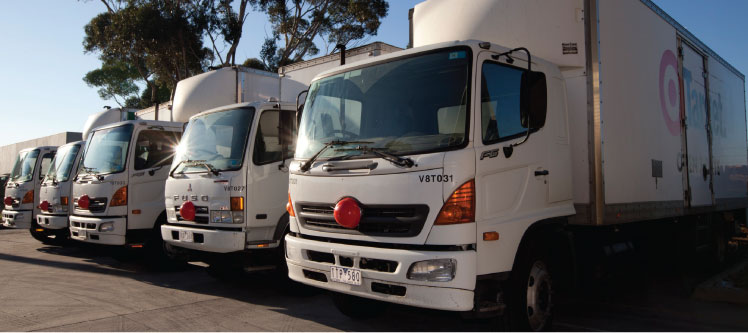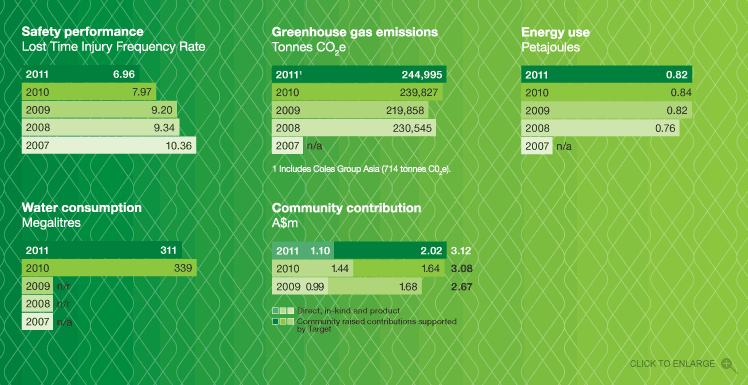Target
Performance overview
Priorities and outcomes
-
Area 2010 Priority Outcome 
Safety Continue to focus on improving safety in manual handling within our business  Achieved
AchievedUpdated online safety training courses for our store team members and introduced purpose-built manual handling equipment at selected sites 
Stakeholder engagement Strengthen communications with suppliers to improve compliance with Target's Ethical Sourcing Code  Partially achieved
Partially achievedCompleted a full review of our Ethical Sourcing Code and business procedures. Our commitment to social compliance continues to be communicated to our supply base 
Community Continue to grow our community programs with a focus on children  Achieved
AchievedWe achieved a key milestone, raising $1 million for The Alannah and Madeline Foundation's Buddy Bags Program since commencing support in 2008
We also raised more than $250,000 for SIDS and Kids, a 24 per cent increase on last year's result
Environment Build on our current processes to further improve recycling and reduce waste  Achieved
AchievedIncreased the quantity of materials collected for recycling at our stores and sites 
Environment Expand our data collection and systems to support further improvement in our environmental performance  Achieved
AchievedContinued to work with our teams in stores and facilities, supported by our service providers to refine and develop our data systems and reporting
Overview of the business
About our business
Offering a unique combination of product, value and convenience, Target is a leading retail destination for fashionable clothing and homewares.
Our core product ranges include ladieswear, intimate apparel, menswear, childrenswear and nursery, accessories and footwear, homewares, electrical, toys and other general merchandise. The majority of clothing is Target-branded, with national brands and licences used to complement the Target range.
At year end, more than 24,000 team members were employed in 172 Target stores and 119 Target Country stores throughout metropolitan and regional Australia.
Year in review
Sustainability continued to be a strong focus for us. We advanced our team member training and safety; continued to review our environmental impact; and worked closely with our key community partners.
We introduced a new safety training package for management team members. We also continued to implement new equipment and modifications to reduce exposure to manual handling risks. This contributed to a reduction in workplace incidents and a decrease in our LTIFR from 7.97 to 6.96.
In 2010, we had a high response rate of 87.4 per cent to our ongoing team member survey.
A key highlight for the year was achieved in October 2010 when we reached $1 million dollars raised for The Alannah and Madeline Foundation's Buddy Bags Program since commencing support in 2008.
In the area of environmental performance, we continued to successfully reduce excess packaging from key merchandise areas in line with our commitment to the Australian Packaging Covenant (APC).
Material issues
- Improve communications, database management and reporting to better engage supply partners to comply with our Ethical Sourcing Code
- Support the safety of team members by reducing manual handling risks within our stores and sites
- Build strong relationships and improve communications with our stakeholders
- Continue to make a positive difference within the Australian community by partnering with organisations that support safe, happy families
- Minimise waste generated by our activities and through the life cycle of our products
- Improve data management and reporting that will further reduce energy use across our business
People
We continued our commitment to the safety and wellbeing of our team members, reducing our lost time injury frequency rate from 7.97 in the previous year to 6.96. A key initiative to improve the safety standards and increase productivity was a new carton conveyor system. After working with a materials handling equipment supplier, we redesigned an existing height-adjustable conveyor system to unload loose loads in shipping containers and trailers. The equipment has variable height and speed settings which eliminate the need to manually push cartons down the conveyor and reduce awkward body postures such as reaching, pushing and twisting.
Safety is important across our business. During the year, we introduced a new instructor-led safety course for all management team members participating in the Target Store Leadership program. This hands-on program complements our wide range of online health and safety training courses.
In August and September 2010, we held ceremonies to celebrate the 285 graduates from our inaugural Future Leaders program, the first stage of our development framework for store management team members. Graduates progress to the Target Store Leadership program in which 521 team members were enrolled in June 2011.
Following a pilot in 2010, we selected 30 high-potential female managers from across our business to participate in the inaugural My Mentor Women's Development program. We also held our first networking event 'Targeting Women in Leadership' to promote the representation of women in senior management and non-traditional roles. As at 30 June 2011, women represented 76 per cent of all our employees and 41 per cent of management roles were held by women.
We continued to roll-out initiatives from our diversity strategy and provided opportunities for eight Aboriginal people to undertake school-based traineeships in Western Australia and South Australia. Following the 2010 cultural awareness training conducted with store managers and the senior leadership team, we provided training to our stores in Fulham Gardens and Elizabeth in South Australia and Kalgoorlie in Western Australia.
During the reporting year, two team members participated in the Jawun Indigenous Corporate Partnership Program in October 2010 and March 2011, each completing secondments to the East Kimberley region.
We celebrated and recognised the achievements of our team members at the annual Target Rondel Awards in August 2010. The 16 award categories included safety, customer service, leadership, community and sustainability.
Environment
In line with our commitment to the APC we continued to reduce excess packaging and develop sustainable packaging guidelines for key merchandise areas such as footwear. For example, by suppliers excluding cardboard inserts from slippers we removed 15.8 tonnes of excess packaging. In total, across footwear we saved more than 63 tonnes of packaging during the reporting period.
Team members participated in the third annual Target Green Week Challenge held in June 2011. The theme 'Rethink, redesign and remove' was about looking at how we can do things differently throughout the business to further reduce our impact on the environment. We conducted a survey in all stores to more accurately measure water use. This was estimated to be a total of 311 megalitres per year which equates to 82 litres per full-time employee per day.
Carbon and energy
Greenhouse emissions
Our total greenhouse gas emissions were estimated to be 244,995 tonnes of CO2e, up 2.1 per cent on last year, and this equates to 64.3 tonnes of carbon dioxide per million dollars of revenue, up 2.5 per cent on last year. Our greenhouse gas emissions were largely due to electricity consumption at our stores, distribution centres and support centres (approximately 88.4 per cent), synthetic gases used in our air-conditioning (approximately 3.6 per cent) and waste disposed off-site (approximately 3.5 per cent).
Energy use
Our main energy use during the year was electricity consumption for lighting in our stores. Total energy consumption was 820,520 gigajoules, down 2.4 per cent on last year. Our total energy consumption per million dollars of revenue was estimated to be 216 gigajoules, down 1.9 per cent on last year. This energy use was mainly 87 per cent electricity and seven per cent fuel.
Energy efficiency initiatives
We continue to evaluate and implement the recommendations from our EEO representative assessments for improving energy efficiency where these are cost effective to the business. Following an energy efficiency trial conducted in May 2011 at selected sites, we identified an opportunity to reduce our energy consumption by changing the temperature settings within stores.
In June 2011, we started a program to adjust the temperature settings by between one and two degrees.
At our purpose-built storage facilities servicing multiple stores we have introduced light sensors that switch off unnecessary lighting and reduce energy consumption. In these sites we have installed large ceiling mounted fans which enable significant volumes to be circulated efficiently. We also retro-fitted existing compactors with new feeders at six sites to accommodate plastic recycling balers.

Thomas Collyer (left) and Tom Bowen using the new carton conveyor system at the Erskine Park storage facility in New South Wales.



Reducing unnecessary packaging
We are committed to reducing excess packaging from our business.
In the footwear department, we saved more than 63 tonnes of packaging over the past year by reducing the use of cardboard, foam inserts, separators and tissue paper.
These savings included more than 19 tonnes of packaging from children's shoes, 34.8 tonnes from women's shoes and 7.9 tonnes from men's shoes. We will continue to develop and revise sustainable packaging standards in key merchandise areas, and as we review other departments we aim to achieve further savings.
Governance
Ethical sourcing
We consistently strive to source products through our socially responsible Ethical Sourcing Code. We reserve the right not to do business with vendors that do not share and demonstrate this commitment and we regularly audit our suppliers' factories to assess their performance. During the reporting period, we completed a full review of our code and business procedures.
In 2010/11, we conducted 430 factory audits; this included 175 audits conducted by third party auditors and we acknowledged 248 factories through our mutual recognition program. Three zero-tolerance issues were detected and one factory was deregistered as a supplier due to poor social compliance.
Compliance
We updated our online training module for Target's Fair Trading Policy to provide a practical learning tool for team members to promote a greater understanding of the new Australian Consumer Law (ACL) introduced on 1 January 2011.
In an external audit for Payment Card Industry Compliance we were assessed to be compliant with all applicable requirements.
Community
We aim to make a positive difference through our nationwide partnerships and by supporting the local communities in which we operate. Our total contribution this year was valued at $3.12 million and includes $2.02 million contributed by our team members, customers and suppliers.
A highlight was the launch of our ongoing community campaign 'We Love Kids' which includes a television commercial which this year supported the recent SIDS and Kids campaign.
Our key partnerships continued to reflect our commitment to 'safe, happy families'. In October 2010, we thanked our customers for helping us reach the $1 million donation milestone for The Alannah and Madeline Foundation from the sale of our red re-usable bags.
During the year, we continued our commitment to local communities across the nation by providing 90 free St John Ambulance first aid courses for parents and carers of children aged 12 and under. Each course is valued at $125. This equates to 1,180 people having the knowledge and skills required to provide basic first aid and emergency care for children.
In November, our annual Christmas gift giving campaign with UnitingCare was relaunched as Operation Santa. Customers and team members donated more than 63,500 gifts and $172,000 worth of gift cards to the appeal which is now in its nineteenth year.
We also supported the SIDS and Kids Red Nose Day, with customers and team members purchasing $250,000 worth of Red Nose Day merchandise from our stores in June 2011, a 24 per cent increase on last year's result.
Through our community donations program, $106,525 worth of gift cards were provided to not-for-profit organisations in our communities to assist with local fundraising efforts.
Stakeholder engagement
We are committed to ongoing engagement with our stakeholders which include customers, shareholders, team members, suppliers of goods and services, and community partners.
Our complaints handling process provides a responsive service for our stores and customers in accordance with the AS ISO 10002-2006 for Complaints Handling and our customer relations team received 60,993 contacts in 2010/11.
We recently became active in social media, providing a new forum for customers to provide feedback.
Each month we monitor customer perceptions, attitudes and behaviours towards the Target brand and use this research to shape future strategies and actions. In 2010, this research led to the introduction of our customer service program Operation Target to improve interaction with our customers.
During the year, we conducted a survey to assess the engagement of our team members, with 20,869 participating in the survey.
We continued to reduce excess packaging and develop sustainable packaging guidelines for key merchandise areas such as footwear.


